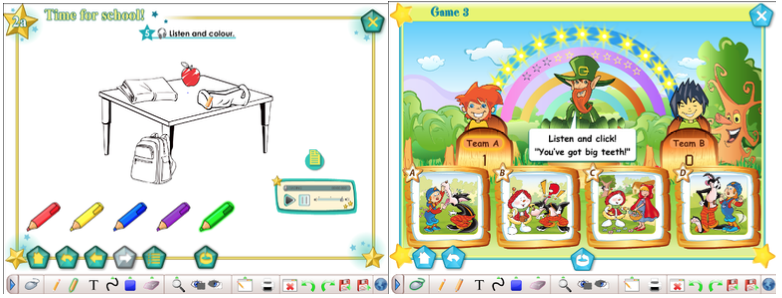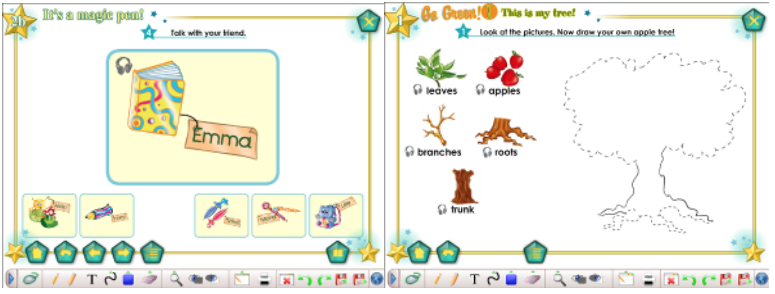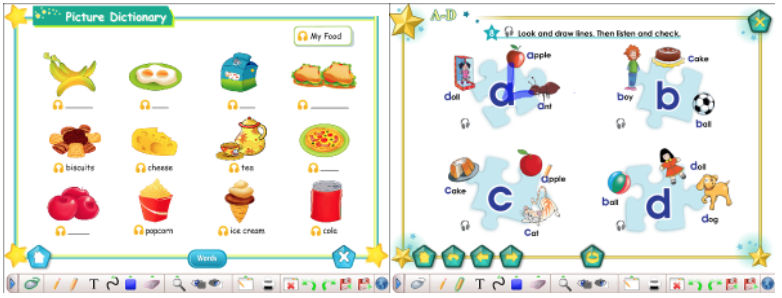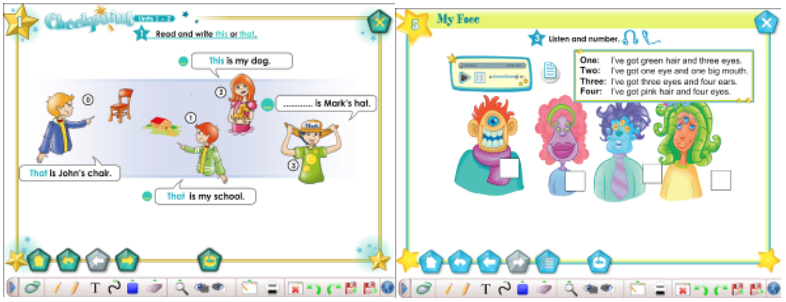

 Vol. 40 (Number 12) Year 2019. Page 10
Vol. 40 (Number 12) Year 2019. Page 10
KOSTIKOVA, Ilona I. 1; GULICH, Olena O. 2; HOLUBNYCHA, Liudmyla O. 3 & BESARAB, Tetiana P. 4
Received:06/12/2018 • Approved: 10/03/2019 • Published 15/04/2019
ABSTRACT: The aim of the research is to investigate the effect of an interactive whiteboard use at English lessons with prospective teachers at school practice and to put the research results into practice. A significant difference was determined in favour of the experimental group, who used an interactive whiteboard systematically at English lessons. The prospective teachers should be prepared well enough to teach English using an interactive whiteboard, as shown by the achievements of young learners participating in the pedagogical experiment. |
RESUMEN: El objetivo del artículo es investigar el efecto del uso de la pizarra interactiva en las lecciones de inglés con la ayuda de la práctica escolar y examinarlo de forma experimental. Se determinó una diferencia significativa a favor del grupo experimental, donde se usaba sistemáticamente una pizarra interactiva en las clases de inglés. Los futuros maestros parecían estar lo suficientemente bien preparados como para enseñar inglés utilizando una pizarra interactiva, lo que se demuestra por los logros de los jóvenes estudiantes que participan en el experimento pedagógico. |
An Interactive whiteboard (IWB) is easy to integrate into modern classrooms for the present digital generation of school learners. An IWB usage in the cotemporary educational system is growing rapidly. One of the aims of high-quality teaching is to raise dynamic individualsready to deal with digital science, innovative technology, and modern society. Many schools are applying a IWB as a new teaching technology for their learners. Interactive whiteboards can positivelycontribute tothelearning process and present many opportunities for both learners and teachers. Interactive whiteboards are widely used in the world of education today, as they are suitable for whole-class teaching and can be used to bring together communication and technological tools that support learners’ production of drawings, tables, graphs, written text, and verbal and video accounts.
Multimedia presentations on IWBs are essential when teaching foreign languages. Interactive whiteboards have a lot of important features of synergies for teaching English to learners of any age. This article is focused on a single academic school subject, English. Interactive whiteboards can provide authentic foreign contexts and meaningful details for literacy learning, discovering new worlds and opportunities. However, the lack of pedagogical experience using IWBs could lead to teachers delivering knowledge and skills insufficiently and ineffectively enough to encourage other teachers to use the mentioned equipment in their practice.
In contrast, applying an IWB at English lessons enhances teaching efficiency by bringing into the classrooms interactivity which generally is a significant pedagogical approach especially needed for low motivated young learners of primary school. Therefore, it is necessary to observe an IWB advantages and its effectiveness for young learners at school. The topic also seems to be fruitful to explore because of the investment costs that IWBs could mean for schools.
It is well-known that audiovisual equipment is very important to ensure permanent learning. The more a planned learning activity appeals to learners’ senses, the more they gain from it. When the concept of time is fixed, learners remember 10% of what they read, 20% of what they hear, 30% of what they see, 50% of both what they hear and what they see, 70% of what they say, and 90% of both what they do and what they say (Aktas, Aydin, 2016).
It is also important to organise the classroom according to the process of teaching by doing and living so that learners may remember what they learn. Sometimes at English lessons at schools they try to recreate an artificial English-speaking environment, which may include unknown words, events that are complicated for learners’ understanding, and consequently causing the feel that English lessons are difficult. These kinds of thoughts can negatively affect learners’ success.
As it is known there are many foreign researches about IWBs as smart boards have been used since the 1990s (Beeland, 2002). Interactive whiteboard became widespread in education since 2002. The mentioned equipment represents technological tools, which are controlled by touching the screen; they can create miracles when used correctly. They can be updated quickly and easily and are considered as an essential part of the classroom (Minor, Bracken, Geisel, & Unger, 2006).
The literature holds many studies related to the positive effects of IWBs on learning environment, students’ concern, and students’ effective participation, young learners’ interest (Al-Faki, 2014; Glover, & Miller, 2002; Glover, & Miller, 2006).
Although modern researches (Schmid, & Whyte, 2012) underline IWB value and its pedagogical practices, only few researches (Aflalo, Zana, & Huri, 2017; Richards, n.d.) are about young learners at English lessons (Kostikova, 2017). Some Ukrainian research articles exist in the literature concerning such a significant interactive whiteboards investment in Ukraine (Holubhycha, & Shatrava, 2017).
Evaluating the returns of those investments in the academic field is important in terms of determining the planning process. However, studies and experience on interactive whiteboards in English classes for young learners have not been widespread in Ukraine. But as applying the mentioned equipment is especially important for the learners having difficulties in English in terms of making the lesson more enjoyable and thereby achieving more effective learning, it is necessary to fill the gap and to have empirical evidence which persuades using IWB for young learners in the English classrooms.
As a result, the current study is aimed to investigate the effect of systematic interactive whiteboard use at English lessons with the help of students at school practice and to examine it experimentally.
In this research theoretical, empirical and statistical methods are used. Theoretical methods (analysis and synthesis) serve to analyze opportunities, advantages and disadvantages of interactive whiteboards as well as their application features and to prepare students to school practice with application of the mentioned equipment at English lessons. Empirical methods (observation, testing, pedagogical experiment) provide conducting the experiment itself, detailed and achievement tests: a pre-test and a post-test in order to collect data for examining the efficiency of systematic interactive whiteboard use at English lessons with young learners. Statistical methods helped make statistical analysis of the pedagogical experiment data; the experiment was conducted in one school (2nd grade experimental group) in Kharkiv, Ukraine.
For four weeks, during a school practice, University students, English prospective teachers, have investigated the group of young learners who studied the program material with supporting interactive whiteboard activities according to the 2017/18 English curriculum.
As mentioned above, IWBs are a relatively new teaching mean in Ukraine. That is why it is important not only for school teachers but also for University prospective teachers to know effective ways of using the equipment in their pedagogic practice. So, at course “The Methodology of Teaching English as a Foreign Language” in H. S. Skovoroda Kharkiv National Pedagogical University, Kharkiv, Ukraine, English prospective teachers are taught how to use IWB for forming and developing English skills with the help of different teaching and learning strategies. The equipment advantages are exposed as well. According to British Educational Communications and Technology Agency (Becta, 2004), these advantages are: increased enjoyment and motivation, greater opportunities for participation and collaboration, decreased need for note-taking through the capacity to print from the screen, and the potential to cater for different learning styles.
However, speaking about didactic support it is essential to warn students against primitive applying IWB as the conceptual growth and activities are very limited when teachers use it as a presenter (Teck, 2013). It is natural that animation, cartoons, virtual demonstrations, photos, movies, English real life action could be a focus for young learners’ concentration. This idea is confirmed by English researchers (Glover, Miller, Averis, & Door, 2007). In addition, the mere introduction of IWBs does not in itself have a transformative effect on either classroom teaching or learning (Smith, Hardman, & Higgins, 2006).
On the contrary, as for integrated interactive activities it is vital to underline for prospective teachers that IWB is used to face young learners a variety of kinaesthetic, visual, verbal stimuli for interaction by touching the screen, writing on it, dragging, dropping etc. Moreover, IWB lessons are different from projecting lessons with ordinary board or screen just because of interaction by touching and moving pictures to the correct answers in order to follow the tasks. The tasks are matching, sorting, labeling as well as navigating IWB activities. In addition, IWB allows learners to present their creative and art work that can be saved for future references, as well as take photos, scan the images for group work and discussions. Amongpractical pedagogical benefits of applying the stated equipment can be named also promoting authenticity and connectedness, multimodality and versatility, efficiency and effectiveness (Teck, 2013).
Another considerable advantage of the equipment is connected with enhanced interaction opportunities between teachers and young learners and reinforcement of familiar patterns of teacher – learner interaction in whole class instruction (Underwood et al., 2010). On the other hand, University lecturers themselves serve as examples when they try to create “proper learning environments”, involving students in interactive learning rather than passively receiving information.
Regarding guided assessment, which is important for pedagogical practice, English prospective teachers during their school practice at Kharkiv school equipped with IWBs taught young learners from the 2nd grade with the help of an interactive whiteboard, organized two tests (pre-test and post-test) to compare the progress.
Thus, the knowledge acquired at the mentioned University course as well as multiple recommendations of University academic staff, English school teachers and University practice advisors helped students to be prepared for modern school lessons provided with IWB. These are the prerequisites for successful performing teaching English pedagogical practice.
As involving interactive whiteboard technology as an alternative to traditional teaching methods facilitates creating “proper learning environment” and, consequently, achieving meaningful education (Aktas, & Aydin, 2016), it is considered to be significant to evaluate the advantages and drawbacks of using IWBs in English classrooms. Therefore, the research approach based on a phenomenological perspective was applied. Considering IWB use by students practicing with young learners, we have summarized the necessary underpinnings of pedagogic practices: didactic support, integrated interactive activities and guided assessment.
The pedagogical experiment was conducted with H. S. Skovoroda Kharkiv National Pedagogical University students who taught the experimental group of 120 young learners from the 2nd grade in Kharkiv school equipped with IWBs school during the practice of English prospective teachers in February 2018. The pedagogical experiment aimed to provide effective learning with the help of interactive whiteboard to compare the results of pre-test and post-test as for developing some skills (listening, speaking, vocabulary, use of English) according to the 2017/18 English language School Program.
The experiment consisted of three stages: 1) the analysis of research literature and pedagogical experience of applying interactive whiteboards at schools with young learners; training prospective teachers to work with young learners; 2) conducting the pedagogical experiment itself; 3) the analysis of the obtained results.
The measurement of the results was done by assessing young learners’ English level of the experimental group (120 young learners); the criteria were listening, speaking, vocabulary, use of English (grammar, correct English). The assessment was based on the following indicators: 1) the ability to speak and listen comprehensively (comprehension was checked through the implementation of tests); 2) the ability to use vocabulary, use of English (grammar).
At the beginning of the experiment, young learners were offered the test to determine the initial English level and to be able to compare the results before and after the experiment. The offered test contained tasks for listening comprehension, speaking, vocabulary, use of English according the Curriculum demands.
In the experimental group interactive whiteboard was used systematically on the basis of the course “Fairyland Express Publishing i-eBook”. The work with the text-book in conjunction with an interactive whiteboard is presented. It included different kinds of communicative and language assessments: tasks for listening and speaking with verbal supports (pictures, samples, keywords, titles, cartoons, animation, phrases, situations); visual supports (images, pictures, photos, painting, series of drawings); visual and verbal supports (pictures, drawings with signatures, photos, animation, images); visual and audio support (cartoons, movies, video clips); without the opportunities to switch off any kind of supports (see picture 1).
Picture 1
The interface of listening and speaking tasks

As for communicative tasks for speaking, they included describing the picture, finishing the story, telling about the friend, learning the vocabulary through the exercises as “Matching”, “Establishing correspondences” (see picture 2).
Picture 2
The interface of speaking tasks

The offered work with an interactive whiteboard for the development of lexical competency included such tasks as identification and differentiation of lexical units, comparative exercises, task for contextual guess, the expansion and reduction of speeches, gaming exercises (see picture 3).
Picture 3
The interface of vocabulary tasks

The assessments directed to the development of competences in use of English (grammar, correct English) contained the following: formation of grammatical competency with the tasks of repeating, identifying and differentiating grammatical phenomena (see picture 4).
Picture 4
The interface of use of English tasks

Our observation has shown that interactive whiteboard use really enhances young learners’ interaction at English lessons.
At the final stage of the pedagogical experiment the young learners were offered the test to control the same skills that were tested at the beginning of the experiment. It was necessary for us to measure the results inside the experimental group itself in listening, speaking, vocabulary, use of English (grammar, correct English). Summarized results of the final test in the experimental group are shown in the table of young learners’ English levels after conducting the pedagogical experiment (see Table 1). The results proved that interactive whiteboard use at English lessons really improved the young learners’ English in listening, speaking, vocabulary, use of English (grammar, correct English).
Table 1
The results in the experimental group in listening, speaking, vocabulary,
use of English (after conducting the pedagogical experiment, %)
Skill |
Level |
The value x² exp. |
||
Low (%) |
Medium (%) |
High (%) |
||
Use of English |
29,82 |
49,12 |
21,06 |
– |
Speaking |
13,33 |
53,33 |
33,33 |
9,241 |
Listening |
13,79 |
51,72 |
34,48 |
9,195 |
Vocabulary |
8 |
55 |
37,3 |
17,298 |
The analysis of the table shows that, firstly, the majority of the young learners confirmed better results in vocabulary (17,298), speaking (9,241), listening (9,195), while only some of them could do the same in use of English. This may be explained by the fact that learners in the 2nd grade are not acquainted with grammar itself and have not got logical thinking yet; secondly, the young learners of the experimental group improved their English vocabulary which is on average almost two times as big as before. The reason may be that the vocabulary development assessments was applied more often, as collecting vocabulary was one of the most important English lesson tasks for this stage of learning. Thus, it will be necessary to obtain other educational objectives (e.g. speaking, listening etc.).
On balance, vocabulary and use of English as well as listening and speaking can be applied within the frameworks of an IWB use, from which follows that an IWB use is the successful tool for the young learners’ progress. Thus, the average progress allow us to claim that the difference in progress is significant, which proves the statistical importance of the results obtained. To our mind, such results are connected precisely with the interactive whiteboard which encouraged the young learners to follow their teacher, and enlarged real-life interaction at English lessons.
The students of H. S. Skovoroda Kharkiv National Pedagogical University, Kharkiv, Ukraine turned out to be trained well enough to be able to apply their knowledge and skills in order to use such modern educational equipment as IWBs while teaching English to young learners at school practice. Systematic interactive whiteboard usage at English lessons with young learners during four weeks of school practice was crucial for this period of time in the context of their development of basic skills in English and, consequently, confirmed the effect of the mentioned device for educational purposes. The examination of the influence of an interactive whiteboard use at English lessons with young learners allowed us to determine and compare the rate of development of the investigated skills in English: beginning with lexical skills – the best learners’ achievements; speaking, listening – developed practically equally; and use of English – the worst results.
The results can adequately reflect the perspective of English teachers using IWBs. This could be in the form of a comparative study across different Universities and schools, to determine if there are any differences regarding IWBs use for various curricula that have been implemented in various educational establishments. Since the IWB’s popularity is expected to grow and develop rapidly, a replication of this study might be conducted periodically in order to examine its trends, prospects.
Aflalo, E., Zana, L., Huri T. (2017). The Interactive Whiteboard in Primary School Science and Interaction. Interactive Learning Environments. doi:10.1080/10494820.2017.1367695
Aktas, S., Aydin, A. (2016). The Effect of the Smart Board Usage in Science and Technology Lessons. Eurasian Journal of Educational Research. 64, 125-138. doi: 10.14689/ejer.2016.64.7
Al-Faki, I. M. (2014). Difficulties Facing Teachers in Using Interactive Whiteboards in Their Classes. American International Journal of Social Science. 3(2), 136-158. Retrieved from https://www.researchgate.net/publication/276418258_Difficulties_Facing_Teachers_in_Using_Interactive_Whiteboard_in_their_Classes
Becta: British Educational Communications and Technology Agency. (2004). Getting the most from your interactive whiteboard: A guide for primary schools. Coventry: Becta
Beeland, W. D. (2002). Student Engagement, Visual Learning and Technology: Can Interactive Whiteboards Help? Retrieved from http://chiron.valdosta.edu/are/Artmanscrpt/vol1no1/beeland_am.pdf
Glover, D., Miller, D. (2006). Running with Technology: the Pedagogic Impact of the Large-scale Introduction of Interactive Whiteboards in one Secondary School. Journal of Information Technology for Teacher Education. 3 (10). doi:10.1080/14759390100200115
Glover, D., Miller, D. (2002). The Introduction of Interactive Whiteboards into Schools in the United Kingdom: Leaders, Led, and the Management of Pedagogic and Technological Change. International Electronic Journal for Leadership in Learning. (6)24. Retrieved from http://www.dm.unipi.it/~didattica/CERME3/proceedings/Groups/TG9/TG9_Miller_cerme3.pdf.
Glover, D., Miller, D., Averis, D., Door, V. (2007). The Evolution of an Effective Pedagogy for Teachers Using the Interactive Whiteboard in Mathematics and Modern Languages: an Empirical Analysis form the Secondary Sector. Learning, Media and Technology. 32 (1), 5-20.
Holubhycha, L., Shatrava, O. (2017). Using Interactive Whiteboard at English lessons for Law Students”. Science and Education. 12, 24-30. doi:10.24195/2414-4665-2017-12-3
Kostikova, I. (2017). Language games in teaching English. Teoriyatametodykanavchannyatavykhovannya. 43, 174-184. doi:10.5281/zenodo.1243599
Minor, B., Bracken, M., Geisel, P., Unger, S. (2006). SMART Boards in the Classroom: The Influence of Interactive Boards in Education. Retrieved from http://tiger.towson.edu/users/sunger2/smart_boards_in_the_ classroom.htm
Richards, L. (n.d.). What Are the Benefits of an Interactive Whiteboard? Retrieved from http://yourbusiness.azcentral.com/benefits-interactive-whiteboard-10097.html
Schmid, E. C., Whyte, Sh. (2012). Interactive Whiteboards in State School Settings: Teacher Responses to Socioconstructivist Hegemonies. Language Learning and Technology. 16(2), 65-86. Retrieved from http://llt.msu.edu/issues/june2012/cutrimschmidwhyte.pdf.
Smith, F., Hardman, F., Higgins, S. (2006). Impact of Interactive Whiteboards on Teacher-Pupil Interaction in the National Literacy and Numeracy Strategies. British Educational Research Journal. 32(3), 443-457.
Teck, W. K. (2013). Affordances of Interactive Whiteboards and Associated Pedagogical Practices: Perspectives of Teachers of Science with Children Aged Five to Six Years. TOJET: The Turkish Online Journal of Educational Technology. 12(1). Retrieved from https://pdfs.semanticscholar.org/606b/244ae187e1cf329859f5038c7f0ebc0ad6ad.pdf
Underwood, J., Baguley, T., Banyard, P., Dillon, G., Farrington-Flint, L. Hayes, M. (2010). Understanding the impact of technology: Learner and school level factors, Becta: British Educational Communications and Technology Agency. Retrieved from http://research.becta.org.uk/index.php?section=rh&catcode=_re_rp_02&rid=17726
1. Doctor of Science in Education, Professor, Department of Theory and Practice of the English Language. H. S. Skovoroda Kharkiv National Pedagogical University, Kharkiv, Ukraine, ilonakostikova@gmail.com
2. PhD in Philology, Assistant Professor, Department of Theory and Practice of the English Language. H. S. Skovoroda Kharkiv National Pedagogical University, Kharkiv, Ukraine, gulich.elena@gmail.com
3. Doctor of Science in Education, Professor, Department of Foreign Languages # 3. Yaroslav Mudryi National Law University, Kharkiv, Ukraine, golubnichaya11@gmail.com
4. PhD in Philology, Assistant Professor, Department of Foreign Languages # 3. Yaroslav Mudryi National Law University, Kharkiv, Ukraine, besarabtp73@gmail.com